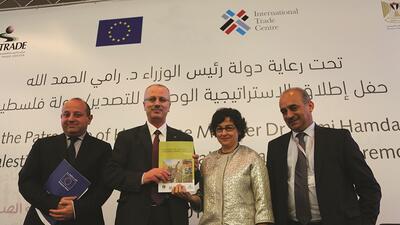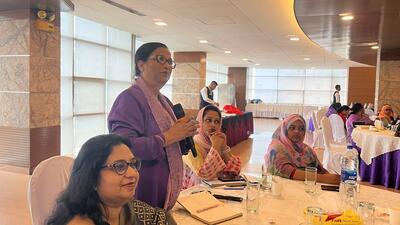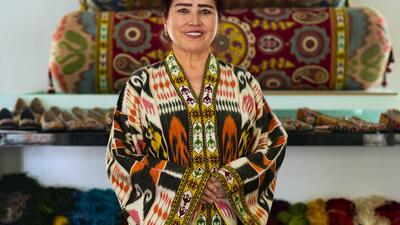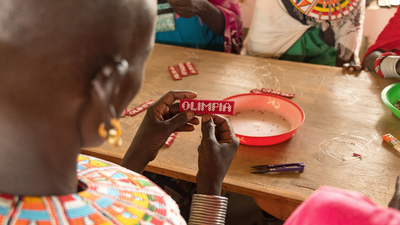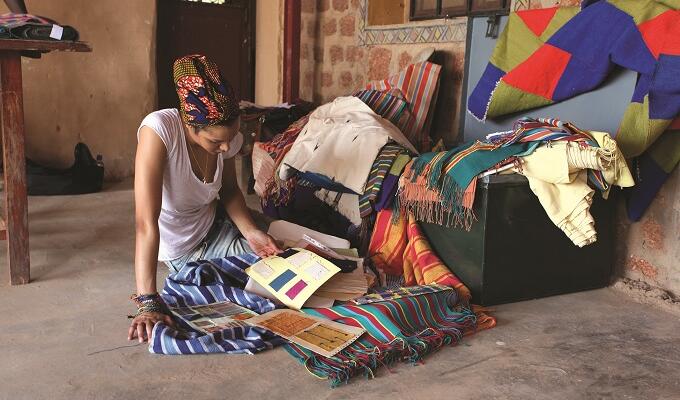

Demystifying ethical fashion with Stella Jean
International Trade Forum talks fashion and development with Italian-Haitian designer Stella Jean on who she made the leap from catwalk to drawing board
Trade Forum: You started off as a model
before deciding to design clothes and
accessories yourself. What made you
take this leap?
STELLA JEAN: At the beginning
I worked on the other side of the fence as
a model but I quickly realized that my real vocation
was of in the creative side of the business,
as a designer. I was in the right place but
in the wrong way to be there. I do not regret
the past as a model because this has helped
to make me who I am today. My passion for
fashion comes from the necessity of finding
my own expressive language. Fashion is my
most authentic communications medium,
through which I have been able to express
and resolve the sense of inadequacy that
guided me through the first years of my life.
TF: How do you work with people
and communities in developing
countries?
SJ: It’s all about creating luxury handwork
produced ethically by disadvantaged
communities, generating work and creating
an infrastructure where the fashion luxury
business can develop and produce products.
Thanks to my sourcing trips I found a rare
treasure looking at the busy hands of extraordinary
women who tell, with dignity and
hard work, a creative and cultural mosaic
without any kind of mystification.
They are excellent handloom weavers,
able to create fabrics of exquisite craftsmanship.
People I met on my trips, in their
villages, showed me that there is a sustainable
future associated with fashion. Today, craftsmanship is the expression of a new
concept of slow fashion and of a responsible
luxury. But the change must first take
place within each of us, in our minds.
It’s a matter of choice, information, diversity
and, at the same time, of cultural identity.
It can cover all phases: design, production,
and consumption.
TF: How does you work make an
impact on the lives of people who work
with you through the International
Trace Centre (ITC) Ethical Fashion
Initiative?
SJ: ‘Not Charity, Just Work’ is the slogan o
f ITC Ethical Fashion Initiative (EFI), which
I firmly support. It is about running a proper,
accountable business that is environmentally
sound. It is about promoting sustainable
economic development and opportunities in
countries that do not need our charity.
TF: How has your Haitian background
influenced your work on fashion
and the collaboration with EFI?
SJ: My personal background has always
played a key role in my inspiration and, Haiti
being my second home, it’s something that
somehow is part of my DNA. When I first
visited Haiti there was not yet a production
hub but ITC already had a team of professionals
in place who managed the community
groups of artisans.
Thanks to the development of my SS2015 collection and to the support of ITC, we got in touch with the Haitian tradition of Art Naïf, discovering such a rare treasure of artisanal and skilled handcrafts and having the opportunity to design these pieces directly with the local artisans. The papier-mâché fruits are produced in Jacmel, the cultural capital of Haiti and home to the country’s largest carnival, for which local artisans craft colourful papier-mâché masks and decorations.
The Horn bracelets are produced in Port-au-Prince atelier of around 50 artisans specialized in horn and bone material. This animal by-product is washed, cut, shaped and polished to perfection to achieve a smooth and glossy surface. The Fer Forgé metalwork jewellery collection was made in several different ateliers that are part of a large community of metalwork artisans based in Croix-des-Bouquets, on the outskirts of Port-au-Prince. There, the local metalsmiths forged the Stella Jean pendants and bangles out of recycled oil drums using just a hammer and physical strength to create the design.
TF: From where do you get your
inspiration?
SJ: From the women of my family. I let
my inspiration be influenced by my own story.
My roots and background have always
played a key role in my work. That is why
I decided to materialize my personal experience
mixing a shirt of my father, to symbolize
the European roots, with wax design
motif fabrics representing the African roots
of Haiti, the native island of my mother
and first independent black republic in the
world.
When I combined these two elements together I finally had my ‘Wax & Stripes Philosophy,’ in which the wax design motif fabrics refer to the Haitian roots of my mother and the masculine stripes to my Italian father. Telling a true story, totally authentic, for the first time has been my strength.
TF: How do you think fashion can
change people’s lives?
SJ: While it will not be easy or quick,
I think that every person is increasingly
becoming aware that a change towards this
approach is proper, inevitable and necessary.
As [ITC Executive Director] Arancha González
said on the occasion of the ‘The Power
of Empowered Women 2014’ event at the
United Nations in Geneva, ‘You can not
change what you do not know, but once you
get it you can not exempt from changing it.’
What I’d like to achieve is that people
begin to understand that each person has [their]
own dignity and deserves to be respected
and not tolerated. You can tolerate a stomach
ache, not a person! But the change must
first take place within each of us, in our
minds. It’s a matter of choice, information and
diversity, and, at the same time, of cultural
identity and it can cover all phases: design,
production and consumption.
TF: Which EFI project/visit impressed
you the most and why?
How is
the EFI influencing your fashion career
and your designs?
SJ: Everything started thanks to my
mentor Simonetta Gianfelici [the Ethical
Fashion Initiative representative for fashion
brand Altaroma] who introduced me to Simone Cipriani (who heads the ITC
initiative). With Simone it was love at first
sight. He is a charismatic man with great
pathos and ideas. I’ve seen his ideas come to
life right before my eyes. He’s as creative as
he’s pragmatic. He gave me the tools to think
beyond aesthetics.
TF: What are your hopes for the
future? How do you envisage fashion
continuing to change people lives?
SJ: If we can mix, in an outfit, elements
coming from the most distant and different
cultures of the world and the result is
good, we can embrace this juxtaposition of
cultures in real life. What I do with my work
is to offer a point of view, which is mine,
but I hope many others will share it in the
coming years. If I were able to get to the
heart of just one person, to make people
understand what is the direction that I
believe we should go, that would already be
a great personal triumph.





